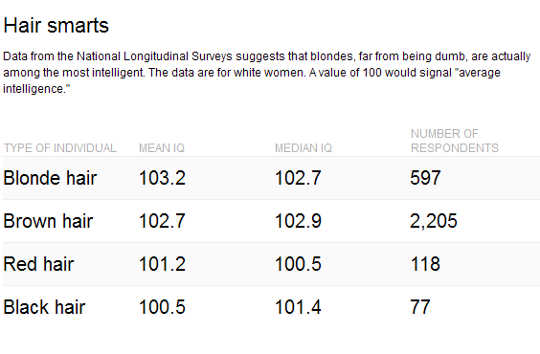
The dumb female blonde is a staple of Hollywood movies, such as Reese Witherspoon in “Legally Blonde.” Amazon currently sells many joke books that poke fun at blondes’ perceived lack of intelligence.
While they are derided for their supposed stupidity, until now no one has actually investigated the question: “Are blondes actually dumb?”
The answer to the question is important. Discrimination is a reality in today’s world. However, many people’s prejudices are based on ill-conceived notions that often don’t match the facts.
I recently published research investigating blondes’ intelligence. The research found that blonde-haired white women – as Witherspoon’s “Legally Blonde” role shows – are certainly not dumb, and blondes might actually be slightly smarter than those with other hair colors.
If this longstanding belief is wrong, how many other commonly held prejudices are also erroneous? How many seemingly harmless biases are actually damaging?
What survey collects this kind of information?
To investigate this question, I used a long-running government program called the National Longitudinal Surveys, or NLS. The NLS repeatedly questions the same individuals over an extended period of time, many from their teenage years until they die. This year is the 50th anniversary of this long-running set of surveys and my 20th year on the project.
Many of you are thinking a government survey that can answer “are blondes actually dumb” is probably just another pork barrel or boondoggle project, like building a bridge to nowhere, in which the government spends millions on questionable projects. However, the NLS has been anything but a pork barrel project.
The NLS was started in the 1960s because the government was very worried about the decline in the number of men working in the U.S. This decline, however, was not a recent phenomenon but instead had been happening steadily since the late 1950s
Some of the early research produced by the NLS pointed out that the reason for this decline was Social Security’s increasing generosity. The program provided a safety net for workers in their retirement, but a side effect was eliminating a need for men to work their entire lives.
The NLS was then expanded in the 1970s to understand the impact of a massive government training program called the Comprehensive Employment and Training Act, or CETA. It was expanded again in the 1990s to understand the labor market problems encountered by millennials.
Why does the survey collect hair color?
But to get back to my main question, are blondes dumber than brunettes or redheads?
The NLS asks questions that, when taken out of context, may seem extremely strange. For instance, in one multiyear survey, the NLS repeatedly asks about a person’s weight and height. Given that most people don’t grow in height after their teenage years, asking respondents to state their height well into their late 20’s is unusual.
Why does the government need to know this kind of information? Since the survey goes back to reinterview the same people over and over again, it is important to make sure the right person is interviewed. Many respondents are provided with a stipend to provide an incentive to answer the survey for the 10th or 20th time. To ensure the correct respondent participates, instead of a brother, sister or roommate, it is very helpful if the interviewer knows someone’s height, weight, eye or hair color.
Knowing that someone shrank by five inches or suddenly no longer has blue eyes and blonde hair is an easy indicator that the wrong person might be answering the survey’s questions. The one drawback to the hair color question is that it is self-reported. Even though the question asked respondents for their “natural” hair color, some respondents might have lied.
Why does the survey track IQ?
The NLS has also tested many respondents’ IQ.
The IQ questions were included because Congress requires the Pentagon to test all military recruits and reject those who are not intelligent enough to handle dangerous weapons (defined by Congress as the bottom 30 percent of the population).
Each military recruit takes a test called the Armed Services Vocational Aptitude Battery before joining one of the U.S. armed forces. Parts of the test are used to determine the best type of job someone is suited for, while another part, called the AFQT, measures innate intelligence.
To determine how AFQT scores match up with the general population, the military needed to know the intelligence of large groups of U.S. teenagers. Two groups of NLS respondents have been used by the Pentagon to determine the fitness of recruits, which provides the second piece of information needed to determine the intelligence of blondes.
The answer might surprise you
Combining the NLS’s IQ data with the hair color information from the same group of teenagers provides the ability to answer the question: are blondes actually dumb?
The surprising answer – at least given the prevalent stereotype – is that among white women, those reporting having blonde hair have the highest average IQ and the second-highest median, or midpoint, IQ. Plus both the mean and median are above 100, which is the value given to a person who has exactly average intelligence.
 The NLS data suggest the Hollywood myth of the dumb blonde is not only a cheap stereotype but in fact a lie.
The NLS data suggest the Hollywood myth of the dumb blonde is not only a cheap stereotype but in fact a lie.
Unfortunately, while the NLS collects information on a diverse range of subjects, it cannot answer the follow-on question, “Do blondes have more fun?” Maybe the next 50 years of collecting data to answer some of society’s serious problems will provide enough information to also answer this question.
In the meantime, if you have believed for years that blondes are less intelligent, stop perpetuating this myth. Regardless of your prior beliefs, spend a minute thinking about all the other prejudices society still blindly assumes are true. My guess is that many of them also will not stand up to careful scrutiny.
About The Author
This article originally appeared on The Conversation
Related Book:
at

Thanks for visiting InnerSelf.com, where there are 20,000+ life-altering articles promoting "New Attitudes and New Possibilities." All articles are translated into 30+ languages. Subscribe to InnerSelf Magazine, published weekly, and Marie T Russell's Daily Inspiration. InnerSelf Magazine has been published since 1985.

Thanks for visiting InnerSelf.com, where there are 20,000+ life-altering articles promoting "New Attitudes and New Possibilities." All articles are translated into 30+ languages. Subscribe to InnerSelf Magazine, published weekly, and Marie T Russell's Daily Inspiration. InnerSelf Magazine has been published since 1985.






















